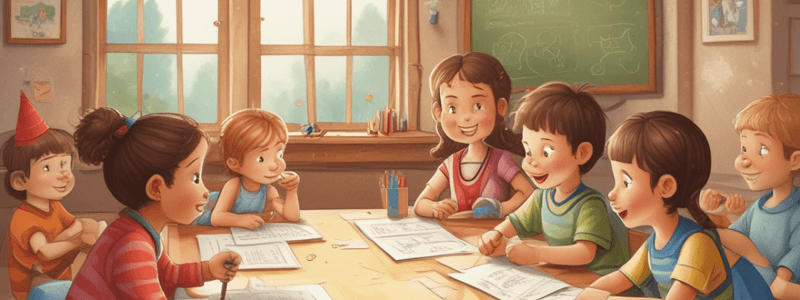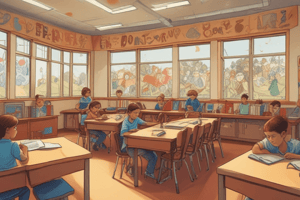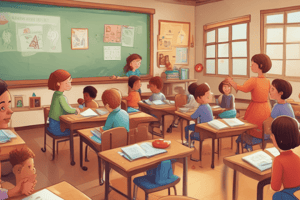Podcast
Questions and Answers
What is the Educator's approach to a child's creative work?
What is the Educator's approach to a child's creative work?
- Embracing their unique perspective and celebrating their authenticity (correct)
- Ignoring their work and focusing on more academic tasks
- Comparing their work to that of their peers and providing feedback
- Correcting their mistakes and guiding them towards perfection
What is the owner's attitude towards trying new things?
What is the owner's attitude towards trying new things?
- Only after extensive planning and research
- Cautious and risk-averse
- Conservative and traditional
- Let's just give it a go (correct)
What is the educator's view on making mistakes?
What is the educator's view on making mistakes?
- Mistakes are irrelevant and should be ignored
- Mistakes are a sign of incompetence
- Mistakes are failures and should be avoided
- Mistakes are opportunities for growth and learning (correct)
What is the educator's goal for the children in their care?
What is the educator's goal for the children in their care?
How does the educator view the children's creative work?
How does the educator view the children's creative work?
What is the educator's attitude towards taking risks?
What is the educator's attitude towards taking risks?
How does the educator view their own role in the learning process?
How does the educator view their own role in the learning process?
What is the educator's approach to a child's mistakes in their creative work?
What is the educator's approach to a child's mistakes in their creative work?
What is the educator's view on the role of creativity in learning?
What is the educator's view on the role of creativity in learning?
What is the educator's attitude towards innovation and trying new things?
What is the educator's attitude towards innovation and trying new things?
Study Notes
Creative Environment in Early Childhood Education
- A creative environment includes high-quality interest areas within the classroom or other spaces throughout the program.
- These areas contain developmentally appropriate materials that allow children to explore, use their imagination, and learn.
Interest Areas in the Classroom
- Every room has certain items that are needed for the children's development, such as:
- A dramatic play area that starts as a housekeeping corner and changes throughout the year to promote different interactions.
- A block area with various materials and tools to encourage creativity and problem-solving.
- A writing table to develop fine motor skills.
- A science and discovery area for exploration and learning.
- An art center with open-ended materials for process-oriented art activities.
The Importance of Arts in Early Childhood Education
- The arts encompass various creative activities that are crucial for the holistic development of young children.
- The arts include:
- Visual arts (drawing, painting, sculpting) to enhance fine motor skills and sensory development.
- Music activities (singing, playing instruments, listening) to aid auditory skills and emotional expression.
- Dance and movement to improve physical coordination and expressive communication.
- Drama and role-playing to foster imagination, empathy, and social skills.
Visual Arts in Preschool Settings
- Visual arts activities stimulate the senses, particularly sight and touch, and encourage children to express themselves and develop skills.
- Visual arts activities include:
- Drawing to develop fine motor skills and expressive abilities.
- Painting to experiment with colors and techniques.
- Collage to foster creativity and understanding of textures and composition.
- Sculpture to develop hand-eye coordination and spatial awareness.
- Printmaking to teach patterns, symmetry, and cause-and-effect processes.
- Construction activities to enhance problem-solving skills and encourage planning and execution.
Fostering Creativity in Children
- Children are born creative, and educators should provide them with the space and opportunities to explore and express themselves.
- Allowing children to get bored and then providing open-ended materials can foster creativity and innovation.
- Encouraging children to take risks and try new things can lead to authentic learning experiences.
The Role of Educators in Fostering Creativity
- Educators should provide access to materials and opportunities for children to explore and express themselves.
- Allowing children to take risks and make mistakes can lead to deeper learning and creativity.
- Educators should be passionate about teaching creativity and thinking outside the box.
- Encouraging children to find their own ways to use information and express themselves can equip them for the future.
Studying That Suits You
Use AI to generate personalized quizzes and flashcards to suit your learning preferences.
Description
Learn about the importance of a creative environment in early childhood education, including setting up high-quality interest areas in the classroom that promote exploration and learning.




